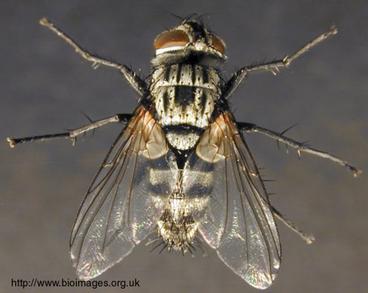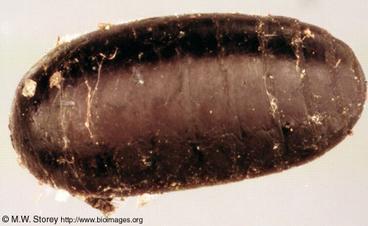R.L. Koch and W.D. Hutchison
Department of Entomology, University of Minnesota
Introduction

Compsilura concinnata (Meigen) (a.k.a. Compsilura) (Diptera: Tachinidae) is a parasitoid native to Europe. This parasitoid is an extreme generalist, attacking over 200 different hosts from three insect orders, including Lepidoptera, Coleoptera and Hymenoptera. Compsilura was initially introduced into North America in 1906 to combat an exotic forest pest, the gypsy moth, Lymantria dispar L. Numerous releases of this parasitoid were made thereafter for a variety of lepidopteran pests. In Minnesota, Compsilura was released, dating back to 1937, for biological control of the fall cankerworm, Alsophila pometaria (Harris). These early releases allowed for a sort of “anticipatory” biological control for the gypsy moth. What this means is that, since Compsilura has the ability to attack so many different host species, Compsilura could become established on alternate hosts before the gypsy moth arrived in Minnesota. Furthermore, the biological control offered by Compsilura has “spilled over” from the forest systems into other habitats such as agricultural crops, including cabbage. Unfortunately, Compsilura appears to be attacking native, non-pest insects too.
Description

Superficially, adult Compsilura are similar in size and shape to the common house fly. More specifically, the adults are about 7.5 mm long, have a white face, and a whitish colored thorax with four black stripes. Pupae are about 6.5 mm long, brown in color, and elliptically shaped (see photo, right). Larvae are cream colored with black mouth hooks and three anal hooks.
Biology & Life Cycle
Three to four generations of Compsilura occur per year, with the larvae overwintering in host larvae. Compsilura adults typically live for five to 22 days. After mating, adult females seek out host larvae. Upon determining that a host is suitable for her offspring, she pounces on the back of the host, uses a piercing structure at the tip of her abdomen to puncture the integument of the host, and then typically injects a single larva into the wound (i.e., larviposition). A female sometimes will sometimes attack the same host multiple times. Larvae are injected either directly into the midgut of the host or into the body cavity (i.e., hemocoel). Larvae injected into the hemocoel rapidly move to and penetrate the midgut. In the midgut, Compsilura larvae develop through three larval stages (i.e., instars). Compsilura remains as a larva for ten to 17 days. Near the time of their hosts’ pupation, Compsilura larvae will emerge from the hosts to pupate in the soil or on some other substrate. Compsilura remains in the pupal stage for ten to 15 days.
Biological Control
Compsilura is considered an important member of the parasitoid complex attacking the gypsy moth. During non-outbreak years of the gypsy moth, parasitism by Compsilura typically ranges from one to 14%. However, up to 80% of gypsy moth can be parasitized by Compsilura. Furthermore, Compsilura has shown a direct spatial density dependent response to gypsy moth densities (i.e., percent parasitism increases with increasing host density). This density dependent response may contribute to the stability of gypsy moth populations by lessening the magnitude of outbreaks and by increasing the amount of time between outbreaks.
Outside of the forest system, Compsilura attacks two economically important pests on cabbage, the cabbage looper, Trichoplusia ni (Hübner), and the imported cabbageworm, Pieris rapae L. In Minnesota, Compsilura first appeared in the cabbage system in 1994, and has persisted with parasitism in the cabbage looper and imported cabbageworm reaching 11.0 and 28.0%, respectively. Examples of other pests attacked by Compsilura include the fall cankerwormon elm trees; cranberry fruitworm, Acrobasis vaccinii Riley on blueberries; and Heliothis species on sunflower. Due to the broad host range of Compsilura, there are likely many other pest insects being attacked. Compsilura appears to be compatible with integrated pest management (i.e., the use of multiple management tactics to suppress a pest population to tolerable levels). Adult Compsilura are relatively tolerant to synthetic insecticides such as carbaryl (carbamate) and permethrin (pyrethroid). However, organophosphates are relatively toxic to Compsilura. Compsilura also shows a degree of tolerance to pathogens such as Bacillus thuringiensis Berliner (Bt) and nuclear polyhedrosis virus (NPV). Finally, Compsilura is generally tolerant of other parasitoid species occurring in the same host. The tolerance of interspecific competition within a host may be due to Compsilura occupying a separate niche from most other parasitoids.
Compsilura inhabits the midgut of the host, whereas many other parasitoid species inhabit the body cavity of the host. For example, Compsilura often emerged successfully from hosts that were also parasitized by another tachinid, Epicampocera succincta (Meigen), or the braconid, Cotesia glomerata (L.). However, this interspecific competition did result in adult Compsilura with smaller body sizes.
Impacts on Non-Pest Insects
Although Compsilura provides useful biological control of some insect pests, exotic organisms often have adverse impacts on native species. Compsilura has three biological attributes that make it particularly prone to affecting native, non-pest insects. First, Compsilura has several generations per year (i.e., multivoltine), whereas its intended host, the gypsy moth, only has one generation per year (i.e., univoltine). Therefore, Compsilura must attack alternate hosts to complete some of its generations. Second, Compsilura must overwinter in a host larva. However, the gypsy moth overwinters as an egg, so Compsilura must utilize alternate hosts for overwintering. Third and most importantly, the broad host range of Compsilura increases the likelihood of non-pest hosts being attacked.
In the northeastern United States, Compsilura has been implicated with the decline in the abundance of several giant silk moths. Percent parasitism by Compsilura in some of these species can be quite high: 81% in the cecropia moth, Hyalophora cecropia (L.), 68% in the promethea moth, Callosamia promethea (Drury), and 36% in the buck moth, Hemileuca maia maia (Drury).
References
Boettner, G.H., J.S. Elkinton, and C.J. Boettner. 2000. Effects of a biological control introduction on three nontarget native species of saturniid moths. Conservation Biology 14: 1798-1806.
Culver, J.J. 1919. A study of Compsilura concinnata, an imported tachinid parasite of the gypsy moth and the brown-tail moth. Bulletin 766. U.S. Department of Agriculture. Washington D.C. 27 pp.
Gould, J.R., J.S. Elkinton, and W.E. Wallner. 1990. Density-dependent suppression of experimentally created gypsy moth, Lymantria dispar (Lepidoptera: Lymantriidae), population by natural enemies. Journal of Animal Ecology 59: 213-233.
Wold-Burkness, S.J., W.D. Hutchison, J.C. Lee, R.L. Hines, P.C. Bolin, and G.E. Heimpel. 2005. A long-term survey of parasitoid species composition and parasitism of Trichoplusia ni (Lepidoptera: Noctuidae), Plutella xylostella (Leipidoptera: Plutellidae), and Pieris (=Artogeia) rapae (Lepidoptera: Pieridae) in Minnesota cabbage. Journal of Entomological Science. 40: 211-221.